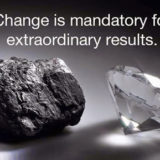
 A stakeholder is anyone who shares (or might share) one or more of your objectives or goals—in other words, anyone who has some stake in the work you do or its outcome. Stakeholders may be inside or outside or the organization. Over the last 20 years, most organizations have undergone radical transformations. They have been downsized, right-sized, flattened, re-engineered, re-structured, and outsourced. As a result, there are few organizations where a command-and-control style of management is still appropriate or effective. In today’s organizations, things get done largely through relationships. To some extent this has always been true, but understanding, building, and managing relationships is a more important part of a leader’s work now than ever before.
A stakeholder is anyone who shares (or might share) one or more of your objectives or goals—in other words, anyone who has some stake in the work you do or its outcome. Stakeholders may be inside or outside or the organization. Over the last 20 years, most organizations have undergone radical transformations. They have been downsized, right-sized, flattened, re-engineered, re-structured, and outsourced. As a result, there are few organizations where a command-and-control style of management is still appropriate or effective. In today’s organizations, things get done largely through relationships. To some extent this has always been true, but understanding, building, and managing relationships is a more important part of a leader’s work now than ever before.
We interact with a multitude of others in the course of our working life, getting and giving feedback through our connections, especially those in a “360°” circle—or web—around us. The language and images that illustrate our work relationships now emphasize the circular, dynamic, and interconnected aspects of work. We need new ways of representing and analyzing our network of stakeholders and how to interact with them to achieve mutual success.
For each stakeholder, there are two levels of relationship you need to focus on:
- Your individual relationship with that stakeholder
- The relationship between your business unit and your stakeholder’s business unit
To be successful in your new role, you need to be able to identify your key stakeholders and to gain their support.
Caution: Do not fall into the trap of focusing only on building coalitions with your supervisor, your senior management, and your immediate team. No leader can afford to neglect the importance of forming solid relationships across and down the organization.
It is natural for others in your network to protect their territory, and their interests may collide with yours. It is important to consider the potential conflicts you may face in your new role, as well as to have a broad awareness of the relationships that will enable you to get things done. Because those relationships may not yet be in place, you need to determine which ones are likely to be critical to the accomplishment of your objectives. A review of your Key Few Objectives will suggest what relationships you need to quickly create, enhance, or, in some cases, repair. Think strategically. There may also be people who are not currently viewed as stakeholders (or who do not view themselves that way) whom you will need to enlist as stakeholders going forward.
Viewing Stakeholders Objectively
You will need to build relationships based on sound observation and judgment, not assumptions. We all tend to automatically assume that certain personality traits go together, usually based on our past experience. Thus, if we meet someone who is friendly and outgoing, we may assume that he is also honest, which may or may not be the case. Psychologists refer to these automatic assumptions about personality as “implicit personality theories,” and note that such assumptions often lead to faulty judgments. Few leaders can afford such miscalculations when dealing with key stakeholders.
Building Stakeholder Relationships: What to Do
Once you have completed your stakeholder analysis, you are ready to begin addressing stakeholder relationships by identifying items to include in your Stakeholder Plan (explained later in this module). This involves three steps:
- Identify the key stakeholder relationships that should be addressed in your Stakeholder Plan. These are relationships with stakeholders who have some interest or stake in at least one of your Key Few Objectives.
- Prepare a list of questions to guide you, and interview at least some of these stakeholders to gain a better perspective on the nature and challenges associated with the relationship.
- Outline stakeholder-related action items that can be added to your Stakeholder Plan.
Good Stakeholder Relationships: Following Up
- Take notes after each stakeholder meeting. Specifically record your stakeholder’s priorities and key expectations of your function.
- Check with your supervisor to validate your perceptions of each stakeholder.
- Engage your team in finding ways to build effective stakeholder relationships.
- Continue to proactively monitor the state of your stakeholder relationships and assess the need to enhance or repair them.
- Draft a formal plan to continue the stakeholder relationship-building process.
Drafting Your Stakeholder Plan
At this point, you should have all the information necessary to build a stakeholder relationship plan. Develop a stakeholder relationship plan that outlines the actions you will take with respect to each stakeholder.
Want More?
Check out Rocket Manager, a program to help you develop excellent management skills and propel your career! Building and maintaining stakeholder relationships is a theme throughout the program.
Learn more at www.theRocketManager.com











